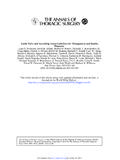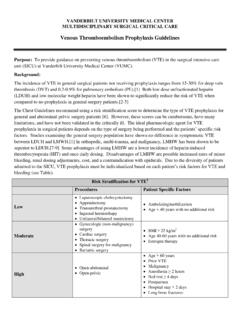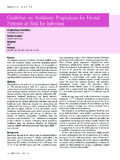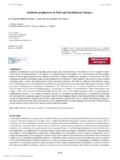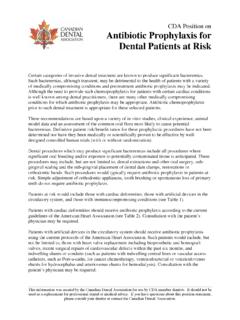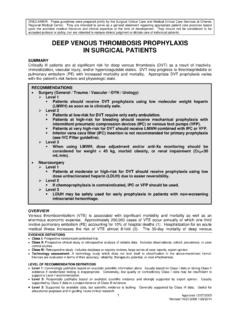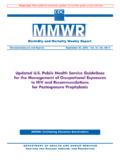Transcription of The Society of Thoracic Surgeons Practice Guideline on the ...
1 REPORT FROM STS WORKFORCE ON EVIDENCE BASED SURGERYThe Society of Thoracic Surgeons PracticeGuideline on the prophylaxis and Management ofAtrial Fibrillation Associated With GeneralThoracic Surgery: Executive SummaryHiran C. Fernando,MD,Michael T. Jaklitsch,MD,Garrett L. Walsh,MD,James E. Tisdale,PhD,Charles D. Bridges,MD, ScD,John D. Mitchell,MD,andJoseph B. Shrager,MDDepartment of Cardiothoracic Surgery, Boston University School of Medicine, Boston Medical Center, Boston, Massachusetts; Divisionof Thoracic Surgery, Harvard Medical School, Brigham and Women s Hospital, Boston, Massachusetts; Department of Thoracic andCardiovascular Surgery, University of Texas MD Anderson Cancer Center, Houston, Texas; Department of Pharmacy Practice , Collegeof Pharmacy, Purdue University, and Division of Clinical Pharmacology, School of Medicine, Indiana University, Indianapolis, Indiana;Division of Cardiovascular Surgery, University of Pennsylvania School of Medicine, Philadelphia, Pennsylvania.
2 Division ofCardiothoracic Surgery, University of Colorado School of Medicine, Aurora, Colorado; and Division of Thoracic Surgery, Department ofCardiothoracic Surgery, Stanford University School of Medicine, Stanford, California, and the VA Palo Alto Health Care System, PaloAlto, CaliforniaAtrial fibrillation (AF) occurs in between 12% and 44%of patients after pulmonary and esophageal sur-gery. Its occurrence is associated with increased pulmo-nary complications, increased length of stay, and in-creased mortality[1, 2]. Although numerous articles havebeen written on postoperative AF, specific recommenda-tions for the prophylaxis and treatment of AF related togeneral Thoracic surgery (GTS) do not exist.
3 Therefore,The Society of Thoracic Surgeons (STS) Workforce onEvidence Based Surgery formed a taskforce to derivepractice recommendations from the follows is an executive summary of the fullguideline available Thefull Guideline includes the complete references and detailedanalysis that fully supports the recommendations listed members reviewed all identifiable publishedreports related to the prophylaxis and management of AFafter GTS as well as selected reports related to medicalAF and AF after cardiac and general surgical for review were selected to inform recom-mendations in three areas: (1) prophylaxis , (2) treatment,and (3) anticoagulation.
4 Levels of evidence were assignedto each publication, and recommendations were maderegardingeach intervention using the American Col-lege ofCardiology/American Heart Association guidelinemethodology. The document was reviewed and approvedaccording to the STS Approval Process for PracticeGuidelines. Evidence-based guidelines must not be viewed as abso-lutes. Guidelines are intended to assist health care provid-ers in decision-making by providing a range of acceptableapproaches for the management of specific conditions. Theultimate judgment regarding care of a particular patientunder specific circumstances must be made by the pro-vider. There are certainly circumstances in which manage-ment that falls outside of these guidelines will and Risk FactorsRisk factors for postoperative AF include male sex, in-creasing age, magnitude of lung resected, magnitude ofesophagus resection, history of congestive heart failure,concomitant lung disease, preoperative episodes of AF,length of procedure[3 15], and procedures associatedwith pericardial inflammation, especially dissectionaround the atria[12, 16].
5 Reproducibly, the highest ratesof postoperative AF occur after pneumonectomies, extra-pleural pneumonectomies, and adult lung transplants[17, 18]. After minimally invasive Thoracic surgical proce-dures, the incidence of AF has been as low as [19].Inone study, 4 of 110 thoracoscopic lobectomy patients( ) had AF[20]. Atrial fibrillation can also developpostoperatively secondary to a wide variety of medicalThe Society of Thoracic Surgeons Clinical Practice Guidelines are in-tended to assist physicians and other health care providers in clinicaldecision making bydescribing a range of generally acceptable approachesfor the diagnosis, management, or prevention of specific diseases or condi-tions.
6 These guidelines should not be considered inclusive of all propermethods of care or exclusive of other methods of care reasonably directed atobtaining the same results. Moreover, these guidelines are subject to changeover time, without notice. The ultimate judgment regarding the care of aparticular patient must be made by the physician in light of the individualcircumstances presented by the the full text of this and other STS Practice Guidelines, the official STS Web site ( ).Address correspondence to Dr Shrager, Department of CardiothoracicSurgery, Division of Thoracic Surgery, Stanford University School ofMedicine, 300 Pasteur Dr, Falk Building, 2nd Flr, Stanford, CA 94305-5407; 2011 by The Society of Thoracic SurgeonsAnn Thorac Surg 2011;92:1144 52 0003-4975/$ by Elsevier including hyperthyroidism, pulmonary em-boli, pneumonia, or onset of AF occurs most commonly on postopera-tive days 2 and 3[1, 7, 21, 22].
7 The risk of arrhythmiasdecreases substantially over the first postoperativemonth, with nearly all patients reverting to preoperativerisk of AF by 6 weeks after coronary surgery, regardlessof treatment[23].Pharmacologic prophylaxis of PostoperativeAtrial FibrillationClass I recommendation: Patients taking -blockers be-fore GTS should have -blockade continued (at reduceddose if epidural analgesia is used) in the postoperativeperiod. (Level of evidence B)Class IIa recommendation: Diltiazem prophylaxis is rea-sonable in most patients undergoing major pulmonaryresection who are not taking a -blocker with -blockers, hypotension may develop in somepatients receiving diltiazem prophylaxis , and dose reduc-tion or other pressure-elevating therapies may be re-quired.
8 (Level of evidence B)Class IIa recommendation: Amiodarone prophylaxis is rea-sonable to reduce the incidence of atrial fibrillation afterGTS (excluding pneumonectomy), according to strict dos-ing regimens. For patients undergoing pulmonary lobec-tomy, the recommended dose is 1,050 mg by continuousinfusion over the first 24 hours after surgery ( mg/h),followed by 400 mg orally twice daily for 6 days. Forpatients undergoing esophagectomy, the recommendeddose is continuous intravenous (IV) infusion at a rate mg/h (1,050 mg daily) for 4 days. (Level of evidence B)Class III recommendation: Amiodarone is not recom-mended, outside of clinical studies, for patients undergoingpneumonectomy, until additional data addressing its po-tential toxicity in this setting are available.
9 (Level of evi-dence B)Class IIa recommendation: Magnesium supplementationis reasonable to augment the prophylactic effects of othermedications. (Level of evidence B)Class IIb recommendation: It may be reasonable toinitiate new -blockers for prophylaxis against postop-erative AF after GTS, but their use is more limited byside effects than diltiazem and thus less broadly appli-cable. (Level of evidence B)Class III recommendation: Flecainide is not recom-mended for prophylaxis of postoperative atrial fibrilla-tion after GTS. (Level of evidence B)Class III recommendation: Digitalis should not be usedas a prophylactic agent against atrial fibrillation afterGTS. (Level of evidence A)Given the morbidity, mortality, and costs associatedwith postoperative AF, it would be beneficial to preventit, if that is possible, with an agent that incurs minimaladverse a meta-analysis of randomized controlled studies ofAF prophylaxis in GTS, Sedrakyan and colleagues[24]included 11 studies[25 35], and we are aware of tworandomized studies published since that time[36, 37].
10 There have been three trials using digitalis[26, 28, 31],five trials with calcium-channel blockers[25, 26, 32, 34,35], two trials of prophylactic -blockers[27, 29], threetrials of amiodarone[34, 36, 37], and single trials offlecainide[30]and magnesium[33]. These trials collec-tively include more than 1,300 recommendation to avoid abrupt -blocker with-drawal is extrapolated from convincing data in the car-diac surgery literature attributing postoperative AF to apropranolol withdrawal syndrome[38]. A meta-analysisof randomized studies of AF prophylaxis clearly demon-strated elevated AF rates in patients whose -blockerswere withdrawn[39].Because GTS patients with epidural analgesia tend tobe mildly hypotensive, we recommend that preoperative -blockers be restarted postoperatively at one half thepreoperative dose, with hold parameters.


